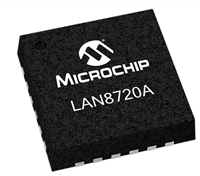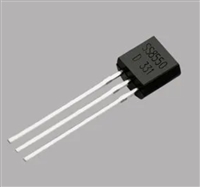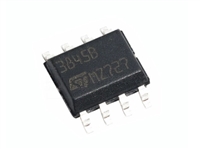subroutine is finished,
a
return from subroutine (RET)
return from interrupt instruction is normally executed to restore
the PC to the value that was present before the interrupt
occurred. The G bit is the reset to one after a return from inter-
rupt is executed. Although the G bit can be set within an inter-
rupt service routine, “nesting” interrupts in this way should only
be done when there is a clear understanding of latency and of
the arbitration mechanism.
instruction is executed. The RET instruction pulls the previously
stacked return address from the stack and loads it into the
program counter. Execution then continues at the recovered
return address.
3.1.5 Status Register (SR)
The 8-bit Status register (SR) contains four condition code indi-
cators (C, H, Z, and N), one interrupt masking bit (G), and an
EEPROM write flag (R.) The condition codes are automatically
updated by most instructions. (See Table 9.)
3.2 Interrupt handling
When an interrupt is recognized, the current instruction com-
pletes its execution. The return address (the current value in the
program counter) is pushed onto the stack and execution con-
tinues at the address specified by the unique interrupt vector
(see Table 10.). This process takes five instruction cycles. At
the end of the interrupt service routine, a return from interrupt
(RETI) instruction is executed. The RETI instruction causes the
saved address to be pulled off the stack in reverse order. The G
bit is set and instruction execution resumes at the return
address.
Carry/Borrow (C)
The carry flag is set if the arithmetic logic unit (ALU) performs a
carry or borrow during an arithmetic operation and by its dedi-
cated instructions. The rotate instruction operates with and
through the carry bit to facilitate multiple-word shift operations.
The LDC and INVC instructions facilitate direct bit manipulation
using the carry flag.
The ACEx microcontroller is capable of supporting four inter-
rupts. Three are maskable through the G bit of the SR and the
fourth (software interrupt) is not inhibited by the G bit (Figure
13.) The software interrupt is generated by the execution of the
INTR instruction. Once the INTR instruction is executed, the
ACEx core will interrupt whether the G bit is set or not. The
INTR interrupt is executed in the same manner as the other
maskable interrupts where the program counter register is
stacked and the G bit is cleared. This means, if the G bit was
enabled prior to the software interrupt the RETI instruction must
be used to return from interrupt in order to restore the G bit to its
previous state. However, if the G bit was not enabled prior to
the software interrupt the RET instruction must be used.
Half Carry (H)
The half carry flag indicates whether an overflow has taken
place on the boundary between the two nibbles in the accumu-
lator. It is primarily used for Binary Coded Decimal (BCD) arith-
metic calculation.
Zero (Z)
The zero flag is set if the result of an arithmetic, logic, or data
manipulation operation is zero. Otherwise, it is cleared.
Negative (N)
The negative flag is set if the MSB of the result from an arith-
metic, logic, or data manipulation operation is set to one. Other-
wise, the flag is cleared. A result is said to be negative if its MSB
is a one.
In case of multiple interrupts occurring at the same time, the
ACEx microcontroller core has prioritized the interrupts. The
interrupt priority sequence in shown in Table 7.
Interrupt Mask (G)
Table 7: Interrupt Priority Sequence
The interrupt request mask (G) is a global mask that disables all
maskable interrupt sources. If the G Bit is cleared, interrupts
can become pending, but the operation of the core continues
uninterrupted. However, if the G Bit is set an interrupt is recog-
nized. After any reset, the G bit is cleared by default and can
only be set by a software instruction. When an interrupt is rec-
ognized, the G bit is cleared after the PC is stacked and the
interrupt vector is fetched. Once the interrupt is serviced, a
Priority (4 highest, 1 lowest)
Interrupt
MIW (EDGEI)
4
3
2
1
Timer0 (TMRI0)
Timer1 (TMRI1)
Software (INTR)
Figure 13. Basic Interrupt Structure
INTR
T1PND
T1
T0PND
T0
Interrupt
WKPND
MIW
Interrupt
Pending
Flags
T0INT
EN
WKINT
EN
G
T1EN
Global Interrupt
Enable
Interrupt Enable Bits
9
www.fairchildsemi.com
ACE1502 Product Family Rev. 1.7






 AT24C256芯片手册参数分析、引脚说明、读写程序示例
AT24C256芯片手册参数分析、引脚说明、读写程序示例

 LAN8720A的替代型号推荐、资料手册数据分析、特点介绍
LAN8720A的替代型号推荐、资料手册数据分析、特点介绍

 SS8550数据手册:应用场景、主要参数分析、特性分析
SS8550数据手册:应用场景、主要参数分析、特性分析

 UC3845全面解析:资料手册参数、引脚详解、维修技巧与替代型号推荐
UC3845全面解析:资料手册参数、引脚详解、维修技巧与替代型号推荐
